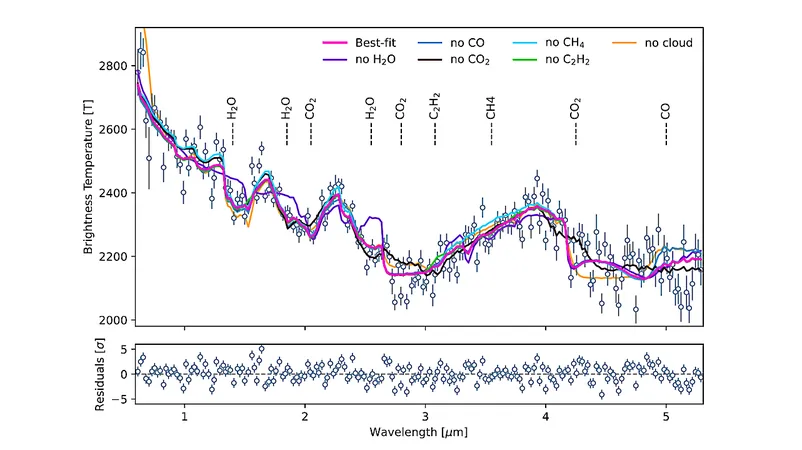
Unlocking the Secrets of Ultra-Hot Jupiters: A Glimpse into WASP-19b's Atmosphere
2025-07-07
Author: Daniel
Exploring the Mysterious Heavens of WASP-19b
Ultra-hot Jupiters (UHJs) are not just distant gas giants; they are rich laboratories for understanding atmospheric conditions far beyond our solar system. Among them, WASP-19b stands out as a fascinating case study with one of the shortest orbital periods known.
Astounding Discoveries with JWST
Recent observations from the James Webb Space Telescope (JWST) NIRSpec/PRISM have unveiled a treasure trove of data regarding the dayside atmosphere of WASP-19b, covering wavelengths from 0.6 to 5.3 micrometers. Scientists detected crucial atmospheric components, including water (H2O) at an impressive significance level of 16.44 σ, carbon monoxide (CO) at 5.47 σ, and carbon dioxide (CO2) at 10.72 σ! These measurements provide a remarkable peek into the planet's chemical makeup.
A Carbon-Heavy Environment
The data paints a portrait of a highly carbon-rich atmosphere, revealing a strikingly high carbon-to-oxygen (C/O) ratio of 0.94 ± 0.03, suggesting abundant carbon-bearing molecules. The study also indicates potential signs of disequilibrium chemistry—a process that could play a significant role in shaping the planet's meteorology!
Clouds of Mystery: Al2O3 at Play?
In a remarkable finding, condensate clouds, presumed to be made of aluminum oxide (Al2O3), have been detected at a staggering significance of 17.28 σ! This discovery hints at complex cloud formation processes in ultra-hot conditions, opening up questions about their impact on climate and weather patterns on the planet.
A Bold New Frontier in Exoplanet Studies!
These groundbreaking results also allow researchers to estimate the atmospheric metallicity of WASP-19b, determining it to be about 1.7 times that of our Sun's composition. Such insights pave the way for more accurate models of exoplanetary atmospheres, particularly those subjected to extreme heat and radiation.
With JWST's unparalleled capabilities, scientists are now equipped to push the boundaries of exoplanet research, bringing us closer to understanding not just WASP-19b, but potentially a multitude of worlds lurking in the cosmic expanse.



 Brasil (PT)
Brasil (PT)
 Canada (EN)
Canada (EN)
 Chile (ES)
Chile (ES)
 Česko (CS)
Česko (CS)
 대한민국 (KO)
대한민국 (KO)
 España (ES)
España (ES)
 France (FR)
France (FR)
 Hong Kong (EN)
Hong Kong (EN)
 Italia (IT)
Italia (IT)
 日本 (JA)
日本 (JA)
 Magyarország (HU)
Magyarország (HU)
 Norge (NO)
Norge (NO)
 Polska (PL)
Polska (PL)
 Schweiz (DE)
Schweiz (DE)
 Singapore (EN)
Singapore (EN)
 Sverige (SV)
Sverige (SV)
 Suomi (FI)
Suomi (FI)
 Türkiye (TR)
Türkiye (TR)
 الإمارات العربية المتحدة (AR)
الإمارات العربية المتحدة (AR)